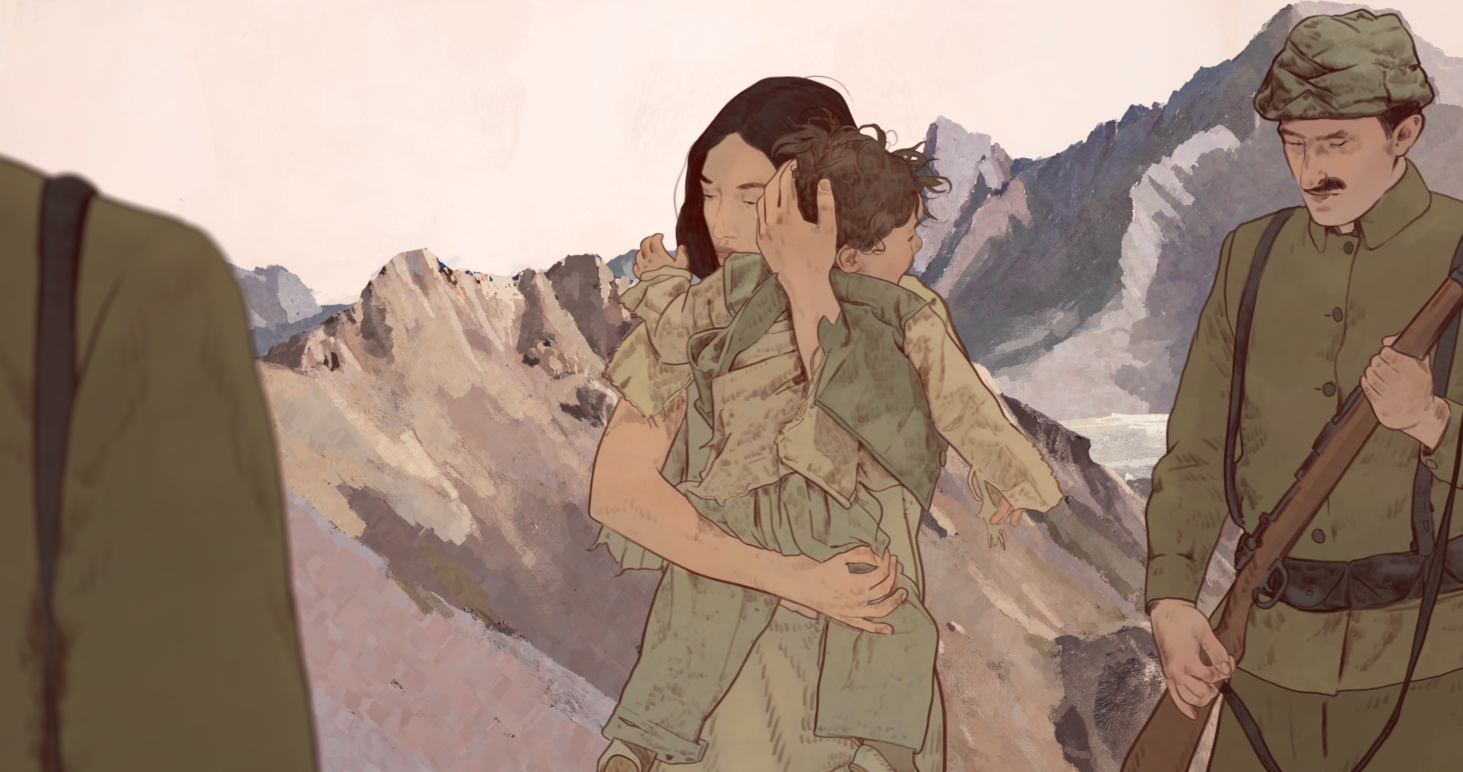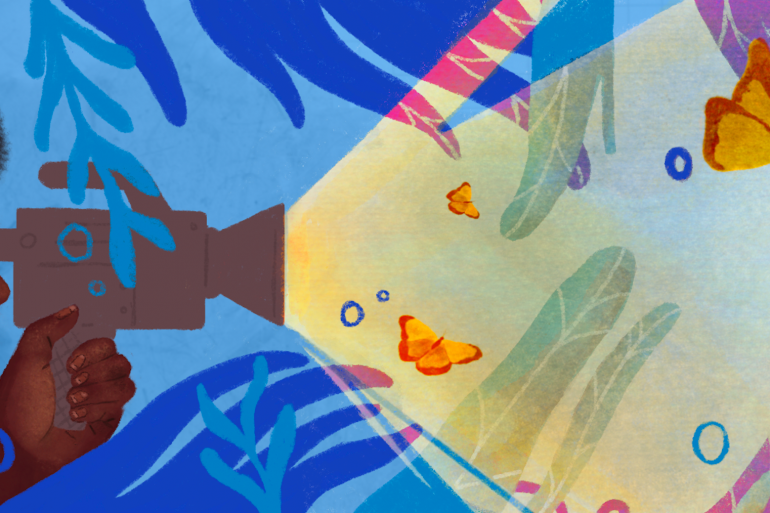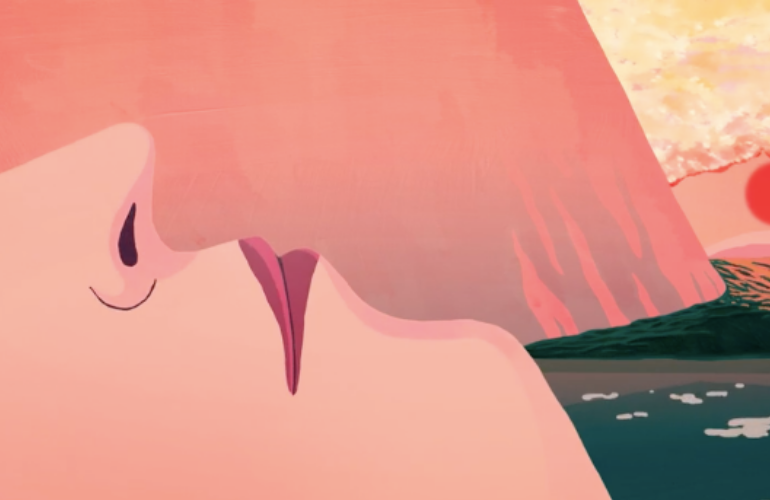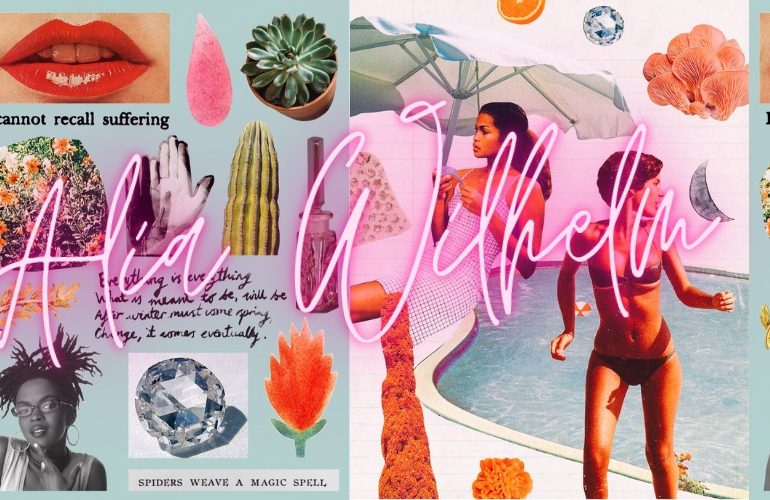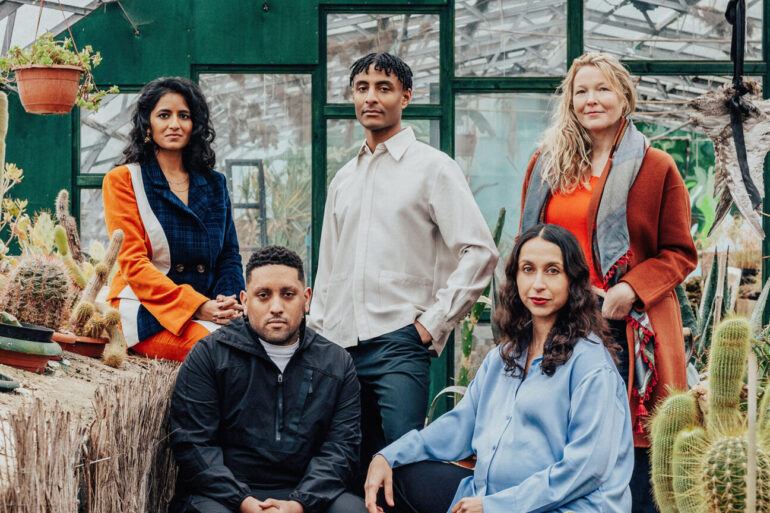The day I interview Inna Sahakyan, director of Aurora’s Sunrise (2022), a documentary which chronicles the horrors of the Armenian genocide, is, by pure chance, the same day I complete the first draft of a play I’m writing about the very same massacre.
As two Armenians meeting, albeit on Zoom, we are, in the words of our compatriot William Saroyan, creating a ‘New Armenia’.
But we are from two very different Armenias.
Inna was born and grew up in the Armenian republic. Her identity firm. Whereas I, with approximately eight million others, grew up in the diaspora – its size a direct consequence of the genocide of 1915.
Our two Armenias – our lives – are only possible, only real, because of the survival of our ancestors. And it is the stories of these ancestors that we’re both drawn to.
Inna approaches these stories with great texture. Aurora’s Sunrise threads a patchwork of animation, archival footage, and interview, as well as clips from a 1919 silent film about the genocide which was once thought lost to history.
The result is a compelling and spirited tale of tragedy and loss, featuring first-person testimony of Aurora, captured by the Zoryan Institute’s Oral History Project.
Aurora is Arshaluys Martikian, born in 1901 in the Ottoman Empire. Aged 14, her family is torn apart as the Ottoman’s massacre and drive Armenians from their homes. She is one of millions, as were my own ancestors, that were ‘death marched’ through the desert. Time after time, against all odds, she managed to survive and escape, eventually reaching America.
Alone, with almost her entire family killed, the trauma of her experience looms over her life in the US. She’s recruited to help raise money for Armenian orphans who’d survived the genocide and her story, her truth, is wrestled from her by young writer Harvey Gates. Gates goes on to write a book and then a Hollywood film which stars Aurora as herself. It is scenes of that movie, Auction of Souls, which are cut in during Aurora’s Sunrise.
When Inna and her team from Armenian documentary production company Bars Media first heard the interview with Aurora, and then learned her story in full, she remembers being struck by both its power, and the difference between Aurora’s own testimony and the version shared in Auction of Souls. One example Aurora herself raises in a later interview is how the sexual and physical violence carried out against Armenian women was not depicted as she had told it.
“Aurora is such an amazing storyteller,” Inna says. “She is a forgotten piece of our past. Her story, when she tells it in the interviews, differs dramatically from the film and the book and so it became obvious that we needed to return her life story, her dignity, to her.” After a pause Inna adds, “and at the same time by returning her life story, we can talk about the Armenian genocide.”

[Still taken from Aurora’s Sunrise]
Away from home, the past becomes more important
The genocide is not a subject Inna ever thought she’d be exploring – a comment that comes as no surprise for me based on my conversations with local Armenians from across the modern day republic.
“I honestly never thought I’d touch the topic of the genocide,” Inna explains. Her two other director credits are documentaries about individuals connected to Armenia. The Last Tightrope Dancer in Armenia (2010) and, more recently, Mel (2022) which follows an Armenian weightlifter who comes out as transgender.
This is where our two different Armenias become clearer. For me, growing up in a rural town in the UK, I was isolated from the wider Armenian community. My father himself knew little of his Armenian identity as he had grown up in the Middle East.
I probed a little, first at university then later as a journalist. Eventually, in 2016, I travelled to Armenia, coincidentally to cover the Aurora Prize (a humanitarian prize set up in memory of Aurora) for the UK press. I expected everyone in my historical homeland to talk about the genocide all the time. After all, in my brief forays into the Armenian diaspora, the genocide framed everything. In reality though many of the local Armenians I spoke to were struggling and attempting to live their lives. They couldn’t live in the past, they were focused on surviving within their modern context.
Inna acknowledges this difference. Now when living between Los Angeles and Armenia, where she interacts more with other members of the diaspora, she sees it even more clearly.
“The past more broadly is really accepted differently in the diaspora than in Armenia,” she says. “I think in the diaspora, you feel more responsible for the past, because you’re not building history within the country.”
Inna continues, “Whereas In Armenia, the fight becomes the country’s responsibility, outside of it, it’s down to individuals and organisations. And for Aurora’s Sunrise, I had to come from my own perspective. Which was coming from the Armenian Republic and talking about the genocide whilst living in Armenia.”
Subscribe to shado's weekly newsletter
Exclusive event news, job and creative opportunities, first access to tickets and – just in case you missed them – our picks of the week, from inside shado and out.

This is particularly pertinent for us Armenians living in the UK where our government still fails to recognise the massacres as a genocide. This is despite the fact that in 1915, the British government commissioned a report by Viscount (James) Bryce and historian Arthur Toynbee, which chronicles the early period of the genocide. Titled The Treatment of Armenians in the Ottoman Empire( 1915-1916), the ‘blue book’, was issued as an official parliamentary report.
In 2015, Human Rights’ Lawyer Geoffrey Robertson revealed what everyone in the British Armenian community already knew – that Turkey was just too important an ally for the UK.
A Freedom of Information request as part of Robertson’s book ‘An Inconvenient Genocide: Who now remembers the Armenians?’ uncovered a memo from the UK Foreign Office. On the government’s position it read:
“HMG is open to criticism in terms of the ethical dimension. But given the importance of our relations (political, strategic and commercial) with Turkey … the current line is the only feasible option.” Ministers were also advised to avoid attendance at any commemoration of the Armenian genocide, and to avoid any mention of it at Holocaust Day memorials.
In the years since then, nothing much has changed. In fact, Armenia has become even more ‘inconvenient’ for the UK after an investigation by Open Democracy found that during the 2020 Armenia/Azerbaijan war, the UK government supported a British-Azeri mining company’s plans to open up the disputed territory of Nagorno-Karabakh for mining.
Trauma echoes from past
One reality of creating the film for Inna and Bars Media was budget limitations. It means the animation – paper-cut computer generated technique – is remarkably simple. But this provides a powerful innocent contradiction to the horrors we see unfold.
“Animation was the way we could talk about trauma but not be too graphic,” says Inna. “We could affect the psyche of the viewer rather than just interpret the events. It allows us to recreate the world that was there, from the really happy and brightest moments to the darkest. And it allows us the freedom to use more imagination, symbols and colours.”
Throughout the film, we’re taken back to Aurora’s idyllic pre-genocide life in Eastern Anatolia. Two motifs from her childhood are used to symbolise the trauma and death she faces throughout her life. One, hinges on a play that she performed with her family as a child, titled: The Three Goats. Each time a family member perishes, we see one of the characters disappear from the stage. The second is the coloured silkworms which her father would dye. At the beginning, when her life was full of colour, we had a whole palette. Slowly, as her world darkens, the screen fills with more and more red.
Red is an important colour to Armenians. The rich red of the pomegranate most famously referenced in Serjei Parajanov’s The Colour of Pomegranates – a film which also celebrates the survival of Armenian culture in the face of persecution and oppression.
“It represents the colour of suffering,” says Sahakyan. “For Aurora, even in the US she cannot leave her past behind, it was always with her. The trauma was always repeating itself.”

[Still taken from Aurora’s Sunrise]
The past and present merge
This is a familiar truth for all Armenians. And one revisited during the making of the film when Azerbaijan, with the support of Turkey, attacked Armenia over Nagorno-Karabakh/Artsakh.
After 44 days, a shaky peace deal was agreed with the supervision of Russia. During the conflict, a number of videos surfaced of Azerbaijani troops allegedly executing and mutilating Armenian civilians and combatants. Amnesty International stated that both Azerbaijani and Armenian forces committed war crimes during the fighting.
In September 2023, the peace deal was broken by Azerbaijan who took control of the entire territory. Although the authoritarian President of Azerbaijan Illham Aliyev said the 120,000 Armenians living in the territory were safe to stay under Azeri rule, almost all of them fled to Armenia proper.
President Aliyev’s offer cannot be taken seriously, particularly against the backdrop of the alleged war crimes committed during the 2020 war, as well as his previous references to Armenians as “rats”, “wild beasts”, “vermin” and the “ugly and savage enemy”. The departure of these 120,000 Armenians can only be seen as ethnic cleansing.
For Inna, working on Aurora’s Sunrise during the 2020 war was the hardest part of the eight year process of making the film.
“It was a challenging project at all levels but I had no idea it would become so current,” she says. “We wanted to give Aurora a voice and talk about historical injustices but it turned into a film which basically reflects current day injustices too. It was very complex to accept this and at one point I really wanted to stop work during the war as the past and the present became very close.”
“I was coming across videos of massacres by Azerbaijani and Turkish soldiers. I wanted to stop because does it make sense to talk about history if you are seeing the same thing right now?”
I was also in Armenia during the 2020 war and, despite never holding a desire to be a war journalist, ended up covering the conflict and its fallout for local and international media. It was a bewildering six weeks or so, with misinformation, rumour, frustration, and an overwhelming feeling of helplessness which still runs deep. So deep in fact that it led me to moving away from news reporting and to experiment in telling stories in different ways.
For Inna, it provided a slightly more determined response which I admire. Once the dust settled, it served as a reminder of where her role in the fight for justice lies.
“The world and humanity has a lot of work to focus on,” she says. “It’s a continuous battle, but we must continue to make the world not a dark place. Our team’s battle was this film and the power of storytelling is our fight for humanity.”
This rallying cry has echoes of Aurora whose interviews in Inna’s film are some of its most illuminating moments. And there are two conversations which carry significant weight.
First, is her response to a question around what was more painful; seeing her family killed or seeing her nation destroyed.
She tells the interviewer that she cannot distinguish between the two. They are inevitably intertwined, including those who survived thanks to her fundraising efforts.
“The colours return to Aurora’s life because Armenians continued living,” says Inna. “We continued to create, to flourish, and now we have our nation, our republic. It was also a way of bringing back her dignity and her story,” she adds. “She was successful, despite the heaviness of the genocide and her Hollywood life.”
The second conversation is when the elderly Aurora is asked what she would like to happen to those who carried out the genocide. Without a pause, she says she doesn’t want revenge with weapons. She wants them to be held accountable for it, to “sit in the chair” of justice so that these horrors won’t be repeated.
“Despite all of her suffering, despite her personal sacrifices,” says Inna, “her belief in humanity wins at the end.”
And so the ghosts of our past continue to haunt us. Because we haven’t faced them. Proven by the repeated disregard for Palestinian life, or by the ethnic cleansing of Nagorno-Karabakh, we continue to be failed by our governments, by our politicians, by our supposed actors. And so it is down to us, as individuals, to come together and tell these stories. To keep remembering and learning.
Because if Aurora, a woman who endured so much, who saw her family killed, who was death marched through the desert and raped and assaulted, if this woman can remain convinced in her belief in humanity, in the power of storytelling, then how can we not?
What can you do?
Read
- An Inconvenient Genocide: Who now remembers the Armenians? By Geoffrey Robertson
- Survivors: An Oral History of the Armenian Genocide by Lorna Touryan Miller, Donald Eugene Miller
- The Forty Days of Musa Dagh by Franz Werfel
- Farewell, Aylis by Akram Aylisli (Author), Katherine E. Young (Translator)
- A mother’s story, a year after the second Karabakh War
Watch
- Parts of a Circle: A history of the Karabakh Conflict
- Bright Garden Voices
- Grandma’s Tattoos
- The River Ran Red
Follow




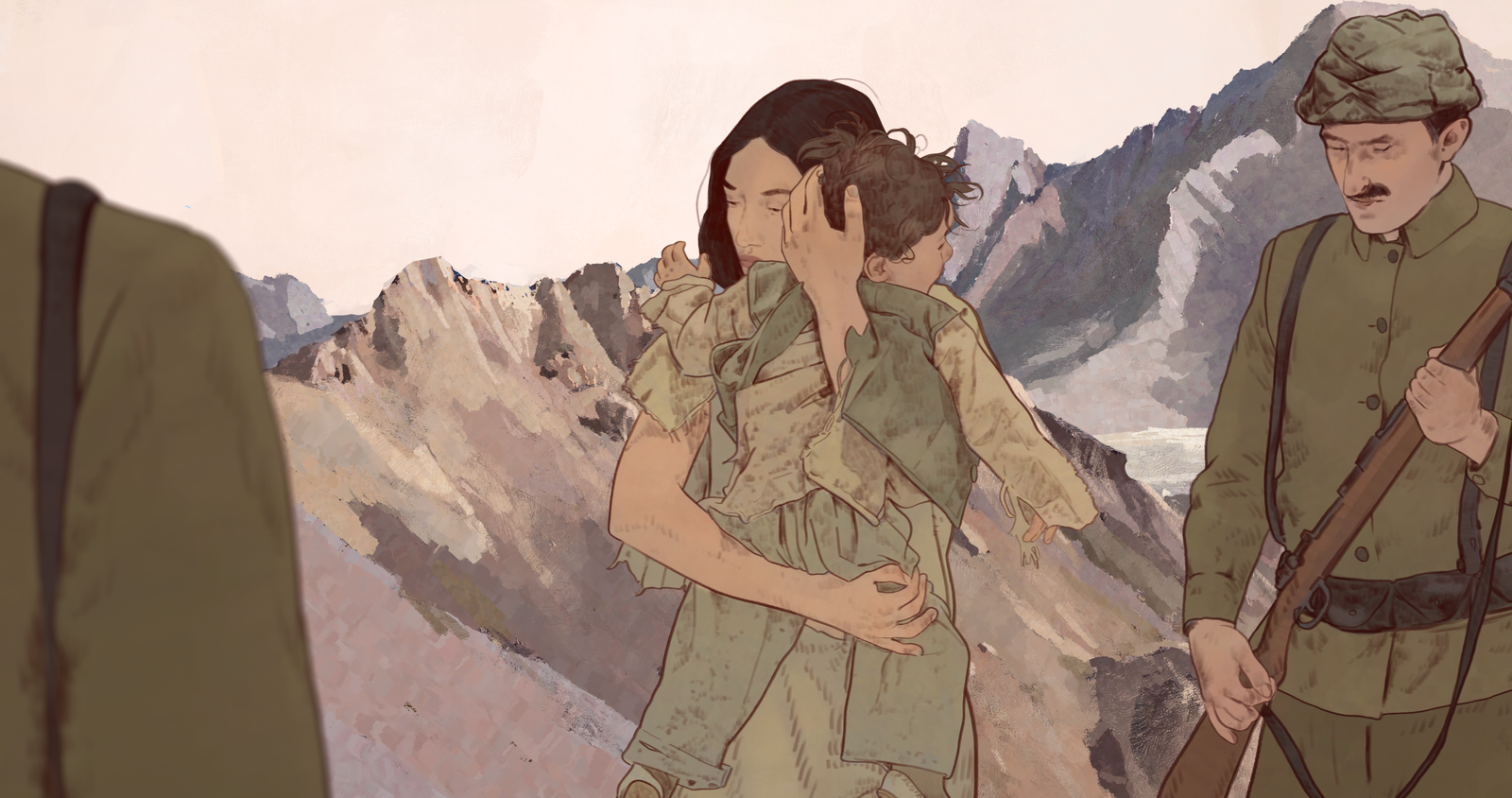
[Stills taken from Aurora’s Sunrise]

